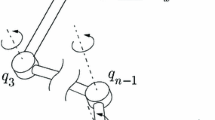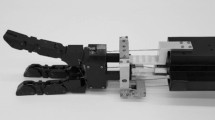Abstract
Multi-finger robotic hands are the main robotic invention for providing assistive movement therapy in hand rehabilitation. In this paper, the concept of task priority is adopted in order to solve the redundancy resolution of a robotic hand. The redundancy parameter has been used to design the inverse kinematic model in order to determine the joint angles when the finger moves to perform the initial subtask of tracing the desired trajectory while considering the secondary subtask of increasing the instantaneous manipulability. Five different human subjects performed the experimentation where the index finger and thumb are allowed to follow the three desired motion trajectories. Markers are placed on the finger joints in order to track the motion and obtain the finger joint angles. Further, the experimental joint angles are compared with those obtained from inverse kinematics. The index finger and thumb behaviour is analysed based on the redundancy resolution scheme. It has been observed that the optimized root-mean-square error remains insignificant of the different subjects performing the motion and the type of motion trajectories adopted for the index finger as well as the thumb. Thereafter, the proposed scheme is applied to a four-finger tendon-actuated robotic hand and it has been observed that the scheme can be applied to solve the redundancies of any robotic hand.























Similar content being viewed by others
References
Razavian RS, Ghannadi B, Mehrabi N, Charlet M, McPhee J (2018) Feedback control of functional electrical stimulation for 2-D arm reaching movements. IEEE Trans Neural Syst Rehabil Eng 26(10):2033–2043
Valero-Cuevas FJ (2009) A mathematical approach to the mechanical capabilities of limbs and fingers. Progress in motor control. Springer, Berlin, pp 619–633
Valero-Cuevas FJ (2005) An integrative approach to the biomechanical function and neuromuscular control of the fingers. J Biomech 38(4):673–684
Valero-Cuevas FJ, Hoffmann H, Kurse MU, Kutch JJ, Theodorou EA (2009) Computational models for neuromuscular function. IEEE Rev Biomed Eng 2:110–135
Valero-Cuevas FJ, Johanson ME, Towles JD (2003) Towards a realistic biomechanical model of the thumb: the choice of kinematic description may be more critical than the solution method or the variability/uncertainty of musculoskeletal parameters. J Biomech 36(7):1019–1030
Yokogawa R, Hara K (2004) Manipulabilities of the index finger and thumb in three tip-pinch postures. J Biomech Eng 126(2):212–219
Yokogawa R, Hara K (2002) Measurement of distribution of maximum index-fingertip force in all directions at fingertip in flexion/extension plane. J Biomech Eng 124(3):302–307
Yoshikawa T (1984) Analysys and control of robot manipulators with redundancy. Robot Res First Int Syposium 1984:735–747
Yoshikawa T (1985) Manipulability of robotic mechanisms. Int J Robot Res 4(2):3–9
Chiacchio P, Chiaverini S, Sciavicco L, Siciliano B (1991) Global task space manipulability ellipsoids for multiple-arm systems. IEEE Transactions on Robotics and Automation 7(5):678–685
Cui L, Dai JS (2011) Posture, workspace, and manipulability of the metamorphic multifingered hand with an articulated palm. Journal of mechanisms and robotics 3 (2)
Daoud N, Gazeau J-P, Zeghloul S, Arsicault M (2011) A fast grasp synthesis method for online manipulation. Robot Auton Syst 59(6):421–427
Sobh TM, Elkady AY, Mohammed M (2009) A New Algorithm for Measuring and Optimizing the Manipulability Index.
Cobos S, Ferre M, Uran MS, Ortego J, Pena C Efficient human hand kinematics for manipulation tasks. In: 2008 IEEE/RSJ International Conference on Intelligent Robots and Systems, 2008. IEEE, pp 2246–2251
Chiu SL (1988) Task compatibility of manipulator postures. Int J Robot Res 7(5):13–21
Neha E, Suhaib M, Mukherjee S (2017) Motion planning for a four-fingered robotic hand. In: Proceedings of the Advances in Robotics. pp 1–5
Nakamura Y (1990) Advanced robotics: redundancy and optimization. Addison-Wesley Longman Publishing Co., Inc., Boston
Faroni M, Beschi M, Visioli A, Tosatti LM (2016) A global approach to manipulability optimisation for a dual-arm manipulator. In: 2016 IEEE 21st international conference on emerging technologies and factory automation (ETFA), IEEE, pp 1–6
Siciliano B (1990) Kinematic control of redundant robot manipulators: a tutorial. J Intell Rob Syst 3(3):201–212
Liegeois A (1977) Automatic supervisory control of the configuration and behavior of multibody mechanisms. IEEE Trans Syst Man Cybern 7(12):868–871
Flacco F, De Luca A, Khatib O (2015) Control of redundant robots under hard joint constraints: saturation in the null space. IEEE Trans Rob 31(3):637–654
Faroni M, Beschi M, Tosatti LM, Visioli A (2017) A predictive approach to redundancy resolution for robot manipulators. IFAC-PapersOnLine 50(1):8975–8980
Singla A, Kulkarni P, Kumar S (2007) Dasgupta B Redundancy control of robot manipulators using task priority. In: International conference on advances in control and optimization of Dynamical systems, pp 72–78
Nakamura Y, Hanafusa H, Yoshikawa T (1987) Task-priority based redundancy control of robot manipulators. Int J Robot Res 6(2):3–15
Pfeiffer F, Johanni R (1987) A concept for manipulator trajectory planning. IEEE J Robot Autom 3(2):115–123
Haddad M, Chettibi T, Hanchi S, Lehtihet H (2007) A random-profile approach for trajectory planning of wheeled mobile robots. Eur J Mech A/Solids 26(3):519–540
Boryga M, Graboś A (2009) Planning of manipulator motion trajectory with higher-degree polynomials use. Mech Mach Theory 44(7):1400–1419
Biagiotti L, Melchiorri C (2010) B-spline based filters for multi-point trajectories planning. In: 2010 IEEE International Conference on Robotics and Automation, IEEE, pp 3065–3070
Xiaoqing G, Jidong W Trajectory planning theory and method of industrial robot. In: 2011 3rd International Conference on Computer Research and Development, 2011. IEEE, pp 340–343
Chen Y, Li L, Ji X (2014) Smooth and accurate trajectory planning for industrial robots. Adv Mech Eng 6:342137
Belić JJ, Faisal AA (2011) The structured variability of finger coordination in daily tasks. BMC Neurosci 12(1):P102
Hu D, Ren L, Howard D, Zong C (2014) Biomechanical analysis of force distribution in human finger extensor mechanisms. BioMed Research International 2014
Friedman J, Flash T (2009) Trajectory of the index finger during grasping. Exp Brain Res 196(4):497–509
Hollerbach J, Suh K (1987) Redundancy resolution of manipulators through torque optimization. IEEE J Robot Autom 3(4):308–316
Flash T, Hogan N (1985) The coordination of arm movements: an experimentally confirmed mathematical model. J Neurosci 5(7):1688–1703
Kim B-H (2008) An Interphalangeal coordination-based joint motion planning for humanoid fingers: experimental verification. Int J Control Autom Syst 6(2):234–242
Secco EL, Visioli A, Magenes G (2004) Minimum jerk motion planning for a prosthetic finger. J Robot Syst 21(7):361–368
Arkenbout EA, De Winter JC, Breedveld P (2015) Robust hand motion tracking through data fusion of 5DT data glove and nimble VR Kinect camera measurements. Sensors 15(12):31644–31671
Lippiello V, Ruggiero F, Villani L (2009) Inverse kinematics for object manipulation with redundant multi-fingered robotic hands. Robot motion and control 2009. Springer, Berlin, pp 255–264
El-Sawah A, Georganas ND, Petriu EM Finger inverse kinematics using error model analysis for gesture enabled navigation in virtual environments. In: 2006 IEEE International Workshop on Haptic Audio Visual Environments and their Applications (HAVE 2006), 2006. IEEE, pp 34–39
Mannepalli S, Dutta A, Saxena A (2010) A multi-objective GA based algorithm for 2D form and force closure grasp of prismatic objects. Int J Robot Autom 25(2):142
Weise T (2009) Global optimization algorithms-theory and application. Self-Published Thomas Weise
Joseph FOM, Behera L, Tamei T, Shibata T, Dutta A, Saxena A (2017) On redundancy resolution of the human thumb, index and middle fingers in cooperative object translation. Robotica 35(10):1992–2017
Orlando MF, Dutta A, Saxena A, Behera L, Tamei T, Shibata T (2013) Manipulability analysis of human thumb, index and middle fingers in cooperative 3D rotational movements of a small object. Robotica 31(5):797–809
Carey JR, Kimberley TJ, Lewis SM, Auerbach EJ, Dorsey L, Rundquist P, Ugurbil K (2002) Analysis of fMRI and finger tracking training in subjects with chronic stroke. Brain 125(4):773–788
Carey JR, Durfee WK, Bhatt E, Nagpal A, Weinstein SA, Anderson KM, Lewis SM (2007) Comparison of finger tracking versus simple movement training via telerehabilitation to alter hand function and cortical reorganization after stroke. Neurorehabilit Neural Repair 21(3):216–232
Lum PS, Godfrey SB, Brokaw EB, Holley RJ, Nichols D (2012) Robotic approaches for rehabilitation of hand function after stroke. Am J Phys Med Rehabil 91(11):S242–S254
Author information
Authors and Affiliations
Corresponding author
Additional information
Technical Editor: Adriano Almeida Gonçalves Siqueira.
Publisher's Note
Springer Nature remains neutral with regard to jurisdictional claims in published maps and institutional affiliations.
Rights and permissions
About this article
Cite this article
Neha, E., Orlando, M.F., Suhaib, M. et al. An effort for resolving redundancy of a multi-finger robotic hand in straight-line motions. J Braz. Soc. Mech. Sci. Eng. 42, 600 (2020). https://doi.org/10.1007/s40430-020-02684-w
Received:
Accepted:
Published:
DOI: https://doi.org/10.1007/s40430-020-02684-w




